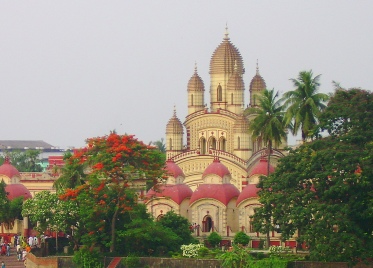
Kali temple where Ramakrishna spent a major portion of his adult life, near Dakshineswar (photo--Wikimedia) |
The Gospel of Ramakrishnaed. by Swami Abhedananda[1907] |

Kali temple where Ramakrishna spent a major portion of his adult life, near Dakshineswar (photo--Wikimedia) |
The Gospel of Ramakrishnaed. by Swami Abhedananda[1907] |
Sri Ramakrishna, (1836-1886) was a Bengali mystic who had a huge impact on the development of modern Hinduism. His chief disciple, Swami Vivekananda, not only helped revive Hinduism in India, but also introduced Hinduism to the West. Ramakrishna was a non-dualist worshippper of the Goddess Kali. However, he also experimented with Christianity and Islam, and repeatedly preached the diversity of paths to God.
This is the story of Ramakrishna told first-hand as a series of days and nights spent with his disciples and lay followers. Imagine someone following Buddha or Jesus around with a steno pad and then publishing candid transcripts of their notes. This is the Victorian-era equivalent. We watch Ramakrishna go into his trances, sing devotional songs, and dispense parables. We get to listen into his profound discourses, including lucid descriptions of very high-level yogic techniques. This is a unique look at a holy man.--J.B. Hare
Production notes: this is a completely new scan of different, and earlier translation of this work than the edition previously seen elsewhere on the web, translated by Swami Nikhilananda. The author listed as "M" was apparently Mahendra Nath Gupta (1855-1932), who transcribed the notes into a five volume Bengali edition, and later translated them into English. The English translations of the Gospel of Ramakrishna, this one included, are derived from his work.
Also at this site: Max Müller's Ramakrishna, His Life and Sayings.